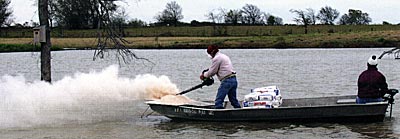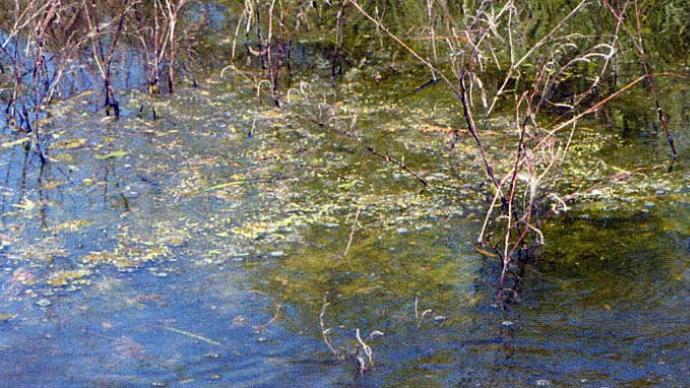
A common practice to manage water quality is to amend it. Biologists tend to take that for granted and sometimes we don't do the best job to define the word amend.
That point was driven home to me during one of my regular Wednesday night Facebook Live broadcasts. The question posed during that session was, "Should I use aglime or hydrated lime?"
If water needs to be amended, it's usually because of just a handful of reasons. For example, rainfall, coming down from the sky, tends to be slightly acidic. To understand reasons to amend water, you need to understand a few basic tenets of how water works.
Water, by itself (which doesn't occur in nature), is just that, pure water. But, in nature, water absorbs everything it can. That's why scientists call water the "Universal Solvent." Anything that can dissolve into water will do so. That means gases, minerals, metals, organic matter, and nutrients. When water touches something, whether the atmosphere, other water, rocks, dirt, an old Volkswagen—it begins to dissolve and absorb stuff.
The next thing to understand is stuff dissolved in water gives value to it, regardless of whether it's perceived to be good or bad for us. Values are measured by pH (acid or base), alkalinity, hardness, and a variety of different individual parameters. From these readings, we judge what to do, if anything.
What spurs most pondmeisters to act is how a pond looks rather than adjusting the chemistry to make it healthier. A perfect example is one of the most common questions we receive, "My pond is muddy, how do I clear it up?" Another common question is, "It's recommended I lime my pond, what do I use?"
In order to answer those questions, we need to know the cause of the problem. That means we must figure out the problem and then explore the best options.
In the case of the fellow asking questions during my broadcast, he has low alkalinity and wants to raise it. Alkalinity is the amount of carbonate dissolved in the water, which acts to buffer pH changes. Higher alkalinity keeps pH stable, because it's the Rolaids of your water. Most of the time, carbonate comes from limestone, calcium carbonate, dissolved in the water. So, if your alkalinity is low, lime may be the best answer. Thus, the question, aglime or hydrated lime. Here's where your learning curve needs to rise. Aglime is mined and crushed limestone—calcium carbonate. Hydrated lime, on the other hand, is calcium hydroxide. That's a manufactured inorganic compound. Common names for it: caustic lime, builder's lime, slack lime, and pickling lime. While it's good for food preparation or helping set concrete and firm up a road base, it won't work to increase alkalinity in a pond. But, it will push up your pH, possibly to levels toxic to fish. Hydrated lime can be useful in conjunction with other processes.
More on that in a minute. Another lime product out there is called Quicklime. That's calcium oxide. That one is used in a variety of industries from concrete blocks to making steel. It really has no use in your pond. If you have a few ounces of quicklime and add a little bit of water, watch out. That's a radical chemical reaction. At the very least, the water will be boiling shortly.

What's the bottom line for increasing alkalinity and buffering the pH of your pond? Aglime—crushed calcium carbonate. If you need aglime where your pond is, chances are highly likely you can buy it locally, because farmers use it on their fields.
What about that other one, that hydrated lime stuff? The application of hydrated lime for your pond is using it in conjunction with Alum, which is another amendment often recommended to clear up a muddy pond—as long as it's strongly monitored. Alum is aluminum sulfate. When added to muddy water, that metal reacts where it separates, and part of it begins to cling to microscopic particles of colloidal clay—the reason a pond is muddy. When adding alum, the applicator monitors the pH as the material is mixed into the pond. The reason for close monitoring is because once alum reaches its breakpoint in water, enough is enough. The clay clings to itself, becomes heavy enough to sink, and then does. More alum in the water exhausts buffering capacity, sending pH plummeting into the acid side. Fish can die from that shock. Hydrated lime buffers that pH change. So, that's a good reason to use hydrated lime, if you know what you are doing.
Another commonly used amendment for muddy waters might be lime. Aglime, that is. Sometimes it works for that purpose, sometimes it doesn't, depending on the cause of muddy water. Aglime adds to alkalinity, whether it clears the water or not. In this case, it's one of those does no harm applications, but it may not work as intended.
Another amendment for muddy water might be gypsum. That's the mineral that is a primary ingredient in sheetrock. Gypsum is calcium sulfate. It's not nearly as volatile as alum, and is often a much safer, just as effective choice as alum. I hope you're beginning to see how these things are tied together. Unless you have a solid understanding of the different mineral amendments and what they do, you aren't likely to see the results you expect.
So, if you think you need to amend your water, Job One is to understand why you need to do that. Job Two, have a fundamental understanding of your water chemistry. If chemistry ain't your deal, seek help to understand it. Job Three, choose the right amendment. Finally, Job Four is to figure out how much of what you choose to use is enough to do what you want.
As simply as I'm trying to make this topic, it's still a little bit complicated. Here's the bullet points.
• Aglime/Calcium carbonate: increases alkalinity in water to buffer pH changes.
• Hydrated lime/Calcium hydroxide: used with alum when clearing water. Won't help with alkalinity in your waters.
• Quicklime/Calcium oxide: don't use it in your pond, period.
• Alum/Aluminum sulfate: cautiously used to clear turbid ponds due to suspended colloidal clay.
• Gypsum/Calcium sulfate: safe clarifier of muddy water, due to colloidal clay suspended.
There's a primer about basic amendments. There's a whole 'nuther article about nutritional amendments, but we'll save that one for another hot, summer day.
Reprinted with permission from Pond Boss Magazine



